Coronavirus (COVID-19): framework for decision making - assessing the four harms
Sets out the four harms process for assessment used to establish when coronavirus restrictions could be safely lifted after lockdown and the scientific evidence underpinning the decisions.
Harm 3
Introduction
The third harm is to our broader way of living and to society that arises from the restrictions which Scotland, together with the other UK nations, have necessarily put in place to slow the spread of the virus. Detrimental effects can include, for example, increased isolation, particularly for those living alone, and the impact on children's well-being from closing schools.
Measurement of social harms is arguably much more complex and nuanced than economic or health measurement. Social harms may be more hidden, less tangible, more subjective, and less quantifiable. We therefore draw on a wider range of data and intelligence to understand them.
We take a number of factors into account. These include:
- Demographics: recognising the differential impacts, for example, on younger people;
- The time horizon and the importance of the longer term horizon recognising future impacts (e.g. consequences of loneliness, poverty, domestic abuse, Adverse Childhood Experiences); and
- The existing socio-economic inequalities in society and how they impact.
The Scottish Human Rights Commission criteria for a human rights-based approach to decision-making provides three additional factors that are used for the assessment process. In summary:
- Maintain minimum services/standards to enable a dignified existence;
- Prioritise the most vulnerable and ensure no discrimination; and
- Limit the extent and duration of any retrogression
COVID-19 affects everyone, but the harms caused by the pandemic are not felt equally. Particular groups (based on Equality Act protected characteristics and socioeconomic disadvantage) are disproportionately affected. It is important to remember that people do not neatly fit into single boxes. People and families will display a combination of different protected characteristics. It is important to remember both the intersectionality of protected characteristics and the wide range of family circumstances that influence the barriers people face and their lived experience. More detailed analysis of the impact of COVID and the four harms across protected groups is available at: https://www.gov.scot/collections/equality-evidence/
Impacts on equalities and human rights need to be reflected across all six dimensions (see table below), with analysis and decision-making recognising that the scale and nature of impacts will vary by protected characteristics. While our data sources do not always allow for breakdowns by specific population groups, we do this whenever we can and seek to supplement routine data and surveys with other sources of intelligence to reflect the experience of specific groups
Table 2 Dimensions of social harms
| Dimension |
Key features |
|---|---|
| 1. Safety and security |
Protection of vulnerable children and adults Crime rates, including cyber, and perceptions of crime Domestic abuse Criminal justice |
| 2. Skills, learning and development |
Early childhood development Student learning and attainment Career progression Participation in educstion, employment or training |
| 3. Social capital and community cohesion |
Ability to turn to someone for help Volunteering and helping behaviours Ability to influence decisions Digital exclusionL |
| 4. Loneliness, anxiety and fear of social interaction |
Levels of loneliness and anxiety Effects of covid-19 on aspects of life Intentions post-lockdown |
| 5. Economic security and welfare |
Benefits claimant rules Fears about household finances, level of debt Sense of purpose and self-respect |
| 6. Social contract, trust in Government |
Trust in advice and experts Compliance with suppression measures Uptake and satisfaction with services Views that Government is doing a good job |
Safety and security
The key factors considered under the heading of safety and security are around the protection of vulnerable individuals and the safety of individuals in the community.
The number of referrals to children's services decreased during the initial lockdown period, but in more recent months have been in line or slightly above equivalent figures for last year. In the week ending 02 December, 233 children were subject to an Inter-Agency Referral Discussion between Police, Health & Social Work, where there was information suggesting potential abuse or significant harm to a child. This compares with 197 such discussions at the same time last year [98].
With people in lockdown, there were increased risks of domestic abuse and child abuse, raised stress and anxiety. Over the period of lockdown and Routemap Phases 1 to 3, many Violence Against Women and Girls organisations observed significant increases in crisis work with victims, with many people experiencing suicidal thoughts, depression and anxiety, increasing substance misuse as a coping mechanism, and/or increased levels of fear, both of the perpetrator and the virus[99]. This position was repeated in a subsequent report updated to include October[100].
Some people find it difficult to self-isolate e.g. the travelling community and homeless and members of LBGT community, if forced to stay with family who struggle to accept them.
Since lockdown there has been an overall reduction in crime recorded by police. The overall number of crimes recorded by the police between April to October 2020 was 7% lower than the same period in 2019. In April 2020 recorded crime was 18% lower than April 2019. For the most recent month - October 2020 - recorded crime was 8% lower than in October 2019.[101]
Changes in police recorded crime is one indicator of the impact that the COVID-19 restrictions are having across society. For example, while there has been a reduction in most types of crime, including violence and sexual crime in April to October (compared to the same period in 2019), there has been an increase in some, such as fraud. Some caution is advised before attributing all changes to COVID-19 as longer term trends, which existed before the pandemic, may remain a factor in some types of offending recorded by the police.
In addition, a procedural change was made in April 2020 to how some crimes of which could involve a victim and a perpetrator in different physical locations are recorded (e.g. crimes which could be committed using digital technologies) and this change is likely to have led to additional crimes being recorded. At this stage we are unable to say to what extent this procedural change has impacted levels of recorded crime, though the 2020-21 National Statistics (to be published in September 2021) will provide users with an estimate of the number of additional crimes that were recorded as a result of this change.
Fraudsters are exploiting the spread of coronavirus in order to carry out fraud and cybercrime. Police have reported an increase in coronavirus related scams[102]. Many fraudsters choose a scam to employ against a particular grouping of people. For example, they may assume that older people are more likely to be at home during the day, and therefore more likely to be susceptible to doorstep crime. Younger people may be more targeted by online fraud, on the assumption that older people are less likely to use the internet, although this may not be the case in future as more older people go online.[103] A Scottish Government analysis of fraud recorded by the police in 2018-19 found that 28% was cyber enabled (i.e. the internet was used as a means to commit the crime). The average age of a victim was 47 years old, which was similar to where cases weren't cyber enabled (49 years old)[104].
The impact of court closures during lockdown has been significant. Courts are now returning to normal levels of activity, remote jury centres are in place for High Court trials and plans are in place for remote Sheriff Jury trials. The majority of court business can be resolved without a trial and latest figures published by the Scottish Courts and Tribunal Service (SCTS) show that the volume of cases concluded in October 2020 was 82% of the pre-COVID-19 level[105]. However, the number of forecast outstanding trials (cases in the system that are likely to have a trial diet fixed) were sitting at 37,900 in October 2020, more than double the 19-20 monthly average figure. Modelling by Justice Analytical Services[106] a few months into lockdown predicted that the justice system could take anything between 2 and 9 years to recover from the court closures, with a medium impact scenario of 4 years. Modelling suggested victims, witnesses and accused may wait an extra 3 to 16 months longer to have their case concluded at trial, with solemn courts (high courts and sheriff solemn courts) expected to have the longest waits and times for recovery.
Furthermore, courts are only one part of the system that is under strain. At the moment, prisons are near capacity and have very constrained ability to adopt single cell occupancy in the event of a local outbreak. Physical distancing has also placed severe constraints on criminal justice social workers (CJSW) who can do less group work and adopt more 1:1 approaches. Should court backlogs be "resolved", the main burden of COVID will be shifted to prisons and to CJSW as more custodial and community sentences are issued while there is no clear mechanism in place to deliver these sentences in a timely manner. Delays to justice, whether in the courts or downstream of courts, have serious implications for people's lives. Delays mean victims and witnesses facing prolonged involvement with the justice system that often forces them to relive traumas. They also mean accused people face the uncertainty of a trial, in many cases with their liberties restricted via bail or imprisoned (via remand) for an extended period in advance of their day in court. They also harm the wider community - those in need of CJSW interventions to help manage their circumstances and reduce their risk of re-offending are left without help and the community as a whole faces greater risks as the size and risk profile of the bail community increases.
Skills, Learning and Development
The consequences of the virus on children and young people have been undeniably negative. This ranges from impacts on early childhood development to school learning and attainment to broader participation in education and training. Children and young people have experienced disruption to their education, restrictions on play and social activities and limitations on family visits and gatherings.
While the lives of children and young people have been severely affected by the virus, the role played by children in transmission is limited. A recent review of transmission in children[107] noted that younger children appear to have a limited role in the transmission of the virus although the risk of the disease and transmission of the disease is likely to be higher in older than in younger children. In Scotland, case numbers match with this, and are far higher for older children with most cases in the 18-19 age range followed by the 16-17 age range and dropping off sharply in younger children. There is no current direct evidence that transmission within schools plays a significant contributory role in driving increased rates of infection among children[108].
There are clear risks in terms of equity and excellence, with disadvantaged learners at greater risk of negative consequences from school closures and home-based learning. Research by the University of Exeter, and the Centre for Economic Performance at London School of Economics (LSE), estimated that disadvantaged pupils could experience learning losses of between four and six months if COVID-19 school closures lasted several months[109]
The impacts on children and young people are multiple. Children's unregulated activities play an important role in the lives of many children. They can be sources of fun, social interaction, physical activity, supervised spaces and vital provision to enable families to work while children are cared for. For vulnerable children, these sorts of activities go beyond simply being fun, they are a vital part of their wellbeing, development and even safety. Evidence from the OECD points out that the ramifications of the COVID‑19 pandemic are more severe for certain groups of vulnerable children, with potential for some far-reaching effects.
The outbreak challenges the resilience of vulnerable children, as it increases, in children's environments, the number of already existing risks (e.g. reduced access to healthy food, high family stress, and absence of contact with supportive adults) and reduces the number of protective factors (e.g. school placements, access to play spaces and extra-curricular activities, and strong child protection systems)[110]
The COVID-19 Advisory sub-group on Education and Children's Issues commented on the need for children to interact:
the psychological literature unequivocally shows that children rely on social interaction with their peers to meet their broad developmental needs, including learning, well-being and positive mental health outcomes. There are particular impacts for children with additional support needs, for whom opportunities to interact regularly with their peers are especially important to facilitate social skills development and personal wellbeing.
Activities that have some direct provision or wellbeing impact on more vulnerable children score highly in societal benefits. From a public health perspective there is a very high negative impact on the physical and mental health and wellbeing and loss of interactions and engagement for large numbers of children and families.
Schools were closed in March due to COVID-19 restrictions. Throughout lockdown, children and young people whose parents/carers are key workers, and vulnerable children and young people, had access to care and schooling in settings outside of the home. This was so that key workers could continue with their work, and vulnerable children and young people had access to safe support and learning. The number of children and young people at education settings gradually increased throughout lockdown, but remained a very low proportion of all children and young people.
From 11 August, schools started to re-open and pupils began to return to school. Provisional figures for 1 December show that the overall attendance rate at local authority primary, secondary and special schools that are open was 90.5%. The percentage of school openings where pupils were not in school for COVID-19 related reasons was 3.3% (1 Dec) and the absence rate for non COVID-19 related reasons was 6.2% (1 Dec)[111].
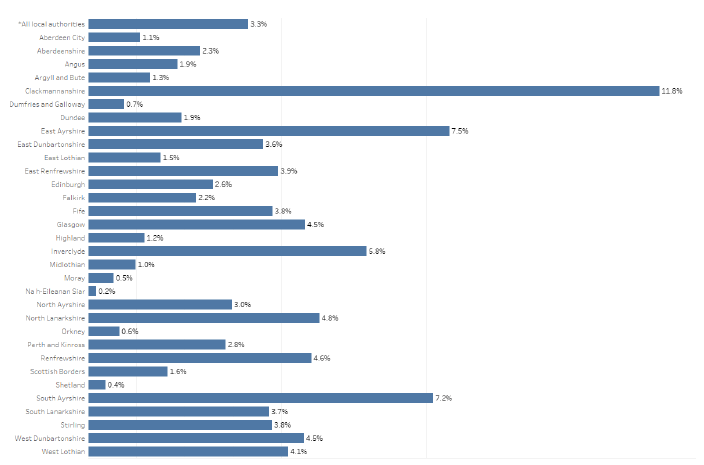
Source: Scottish Government COVID-19: daily data for Scotland
Students and young people are also likely to be amongst the worst affected by economic impacts of COVID-19. Young people have historically been hardest hit by recessions and the longer-term consequences of these. Young people may experience lasting damage if they enter the labour market during a recession. If they find a job earnings may be up to 6% lower after one year than they were for non-recessionary cohorts and still 2% lower after five years, according to the Institute for Fiscal Studies (IFS). This effect is particularly evident for school leavers[112] .
Young people themselves are concerned about the impact on their wellbeing and their future. ONS data on the social impact of COVID-19 on young people shows that among young people (aged 16 to 29 years) who were worried about the effect COVID-19 was having on their lives, their main concerns were the effects on schools or universities (24%), their well-being (22%), work (16%) and household finances (16%)[113].
In April 2020, the Scottish Youth Parliament, YouthLink and Young Scot published findings from a survey of 2,421 young people[114]. At the time of the survey, 11% of respondents were at university and 8% were at college. Of those who answered a question about their employment situation, 36% said they were moderately or extremely concerned. Of those who answered a question about their financial situation, 30% said that they were moderately or extremely concerned.
The most recent study amongst students was run between 3 and 8 November by the ONS who ran a pilot student COVID-19 insight study[115], with 4,322 students responding via an online platform from a small sample of universities in England and one university in Scotland. Key relevant findings from these experimental statistics include:
- On average, 65% of respondents indicated that their wellbeing and mental health had worsened since starting in the autumn term of 2020: 33% said 'slightly worse', 32% said 'much worse';
- This represents an increase on the previous wave of the pilot[116], when 49% of students reported worsening wellbeing and mental health;
- Reports of worsening wellbeing and mental health were highest among undergraduates who are not first year students (73%), followed by 60% of first year undergraduates, and 52% of postgraduate students;
- 80% of respondents think that COVID-19 poses a major or significant risk to friends and relatives. 66% think that COVID-19 poses a major or significant risk to themselves;
- The mean life satisfaction score for the whole population of students was 5.7, which is statistically significantly lower than the life satisfaction of the general population in Great Britain at 6.5[117]; and
- When asked how anxious they felt yesterday on a scale of 0 to 10[118], students reported an average score of 6.5. This is statistically significantly higher than the anxiety rate of the general population in Great Britain (4.3).
Social capital and community cohesion and loneliness, anxiety and fear of social interaction
More than 900,000 people live alone - over a third of Scottish households [119]. Social capital, cohesion and issues of loneliness are particularly important when considering this group within the population.
An overview of a small number of indicators shows deterioration in aspects of community cohesion, contact and loneliness, see Figure 22.
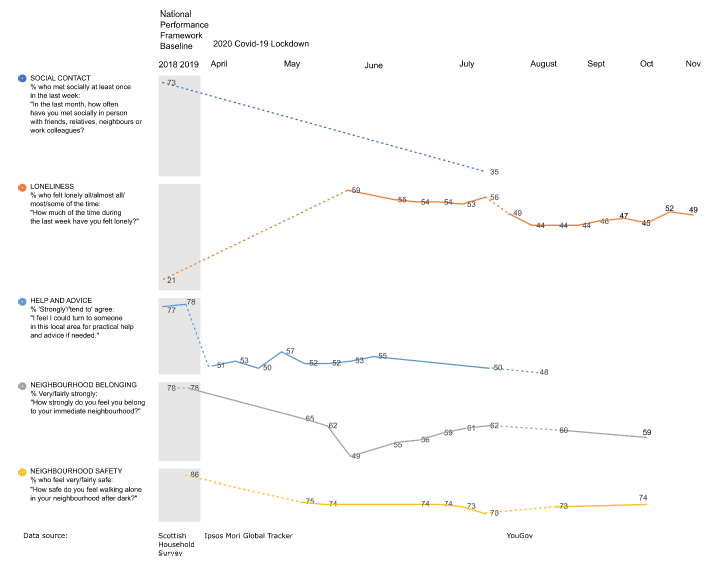
The above indicators show a downward trend in all aspects of community cohesion and a rise in the levels of loneliness. A meta-analysis of public health studies indicated that lack of social connection heightens health risks as much as smoking 15 cigarettes a day or having alcohol use disorder. It also found that loneliness and social isolation are twice as harmful to physical and mental health as obesity.[120]
Weekly polling data is used to monitor loneliness and anxiety. A summary of findings on loneliness shows that:
- 47% report that they experienced loneliness in the past week (YouGov, 1-2 Dec) which is higher than the pre-COVID-19 benchmark (21%); and
- Loneliness is particularly high amongst those aged 18-44 compared to those aged 45+ (YouGov).[121]
Loneliness may be more of an issue for households and individuals without internet access. In general, older people are less likely to have internet access and even if they do they are less likely to use it:[122]
- 36% of households, where all adults are over 65, do not have home internet access, with only 57% of over 65 year olds with internet access using it at all; and
- 60% of households where all adults are over 80 do not have internet access, with 72% of over 80 year olds not using it at all.
People living with low income are less likely to have internet access or to use it: 20% of low income households do not have internet access and 16% do not use it regularly.
Looking at happiness and anxiety, the figures show a degree of stability:
- Over a third (36%) report high anxiety and 19% report low happiness (YouGov, 1-2 Dec) which has remained fairly stable since April, as shown in Figure 23.
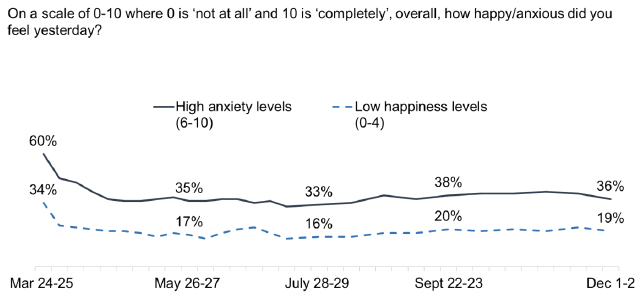
- Worry about the Coronavirus situation (65%) remains high and stable. With the festive period coming up, around three quarters (77%) are worried about increasing the spread of the virus among older and more vulnerable people if restrictions are eased, and around a third (32%) are worried about their mental health (YouGov, 1-2 Dec).
- Optimism that things will start to get better soon has risen in recent weeks, from a fifth (22%) agreeing that things will get better soon at the end of October (27-28 Oct), to almost a half (47%) at the beginning of December (YouGov, 1-2 Dec).
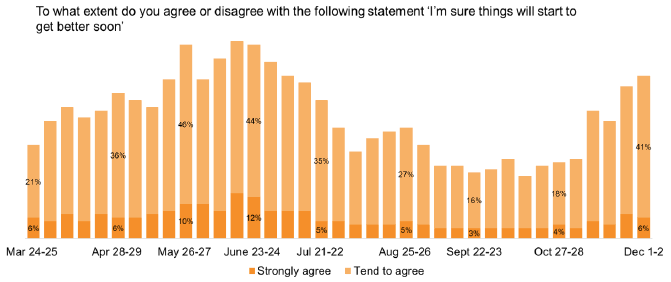
Economic security and fears
Prior to the COVID-19 pandemic, 19% of working-age adults in Scotland were in relative poverty (after housing costs) equivalent to 640,000 adults; 24% of children (230,000 children) were in relative poverty
Women are more likely to have caring responsibilities which may make it hard to maintain or take on employment if childcare and/or public care services are restricted. Evidence suggests that with school and nursery closures, housework and childcare have fallen more on women than men. Carers UK estimate that the number of unpaid carers has increased in the UK by 50% as a result of the pandemic, bringing the total to 13.6 million. Women are more likely to be providing this care [123].
Income deprivation can be found across Scotland but particular areas of Scotland are more likely to be affected. Recognising this differential impact across local authorities is an important element of the levels approach.
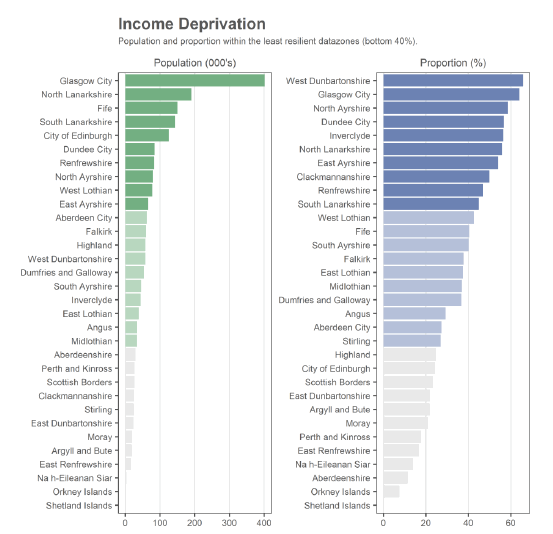
In recent polling, one quarter (25%) perceived a high or very high threat to their job from Coronavirus (YouGov, 1-2 Dec).
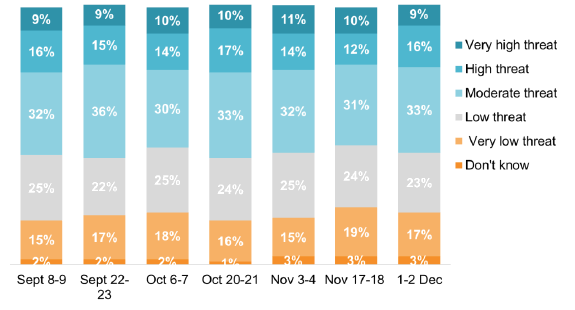
YouGov weekly Scotland survey. Base: Those in employment (n=405-467)
Between one in seven and one in eight of those surveyed were 'very' or 'extremely' concerned that they won't be able to pay bills, have a job, or be able to provide for their household in one month's time.

Source: YouGov weekly Scotland survey. Base (n=1005-1012)
One of the key sources of financial support available to those in need is the Scottish Welfare Fund crisis grant. The Scottish Welfare Fund is administered by local authorities. Crisis grants aim to help people who are in crisis because of a disaster or an emergency.
In March 2020 demand for crisis grants started increasing rapidly compared to previous years and peaked in April 2020. Demand then decreased until July 2020, but remained higher than in the same months in 2019 before increasing again in September and October 2020. It is likely that these increases in demand for Crisis Grants have been due to financial hardship resulting from COVID-19. Applications were 25% higher in October 2020 than in October 2019 as shown in Figure 28.
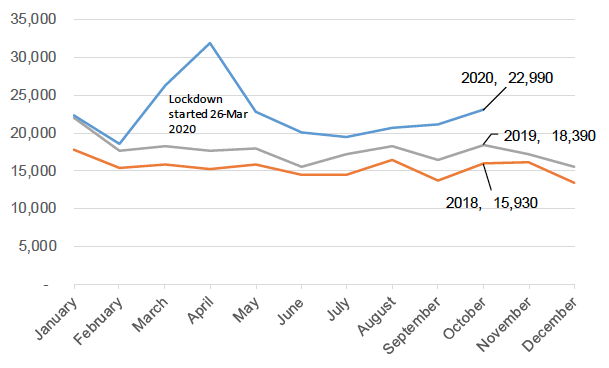
Source: Scottish Government[124]
Having a job can also be challenging as the default of working from home is difficult for some people, particularly those in more crowded accommodation and in lower paid jobs. Additional concerns regarding the costs of working from home during the winter will also affect wellbeing. A business survey shows that in early September[125]
- 27% of people were working remotely;
- 55% of people back at their normal work; and
- 15% still on furlough
The percentage working from home had hardly changed from June when 28% were working from home and 35% were at their normal work. The change in the proportion of people at work has come about from people coming off furlough.
Employees may also be anxious about returning to work. As more parts of the economy remain open or open up, they will need assurance about safety to enable them to continue to work in a safer environment and supporting the functioning of the economy. That should be positive for employees' mental wellbeing. This should also have a positive impact in particular for those in lower socio economic groups and from the BAME community regarding transmission risks, income and poverty and isolation.
Social contact/trust in government
Trust in Government is a crucial underpinning to compliance with restrictions and for supporting general population wellbeing. Clarity about what is required is also important for reducing anxiety and promoting wellbeing. Polling over time shows that trust in the Scottish Government's approach to handling Coronavirus is largely positive and stable:
- Three quarters (75%) agree that following the Government's advice is the best thing to do (YouGov, 1-2 Dec)
- The majority (58%) trust the Scottish Government to decide when and how it's best to lift and re-impose restrictions (stable with the end of October) (YouGov, 1-2 Dec)and
- Two thirds (66%) trust the Scottish Government a great deal/quite a lot to work in Scotland's best interests (YouGov, 1-2 Dec). This was 71% at the end of October (YouGov, 20-21 Oct).
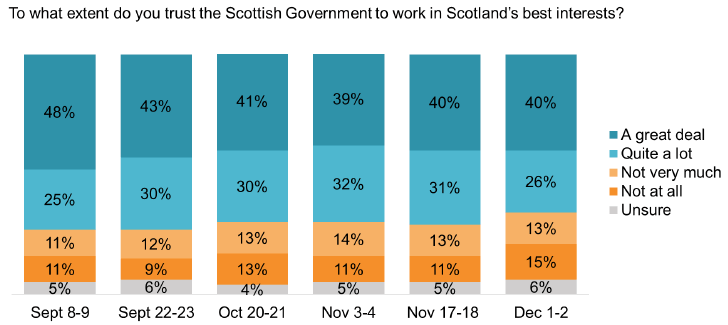
The majority feel clear about what is required of people (70%) (YouGov, 1-2 Dec), stable since the beginning of October, although this is down from 81% in mid-August (YouGov, 11-12 August).
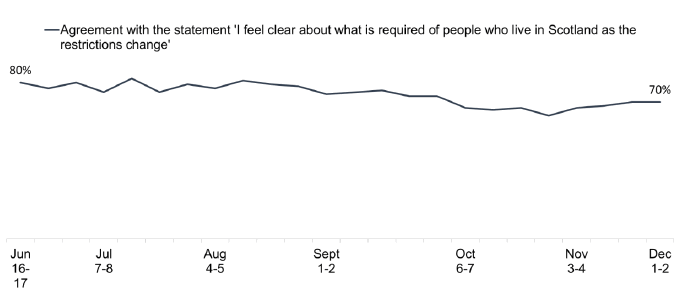
- Just under a quarter (23%) admit to doing something outside the restrictions or guidance in the past week and 19% have met up with other people in a way that is outside of the guidance (YouGov, 1-2 Dec).[126]
Conclusions
Approaching the winter, negative social impacts may be amplified. Those already closest to the poverty line will struggle most and may have used up any reserves they had earlier in the pandemic. We know that many families have very limited savings.
In winter weather, outdoors living is less attractive and people may be even more confined in their homes leading to increased problems of domestic violence and abuse. The public mood is worried about the future and unsure what is happening,
There will be fear of increased isolation and loneliness for some groups. We are already seeing increased mental health problems including amongst younger people.
Throughout the pandemic, negative impacts fall most severely on those in lower socio-economic groups, for example, through increased transmission risk, through inability to work from home, income loss from workplace closure, loss of access to health services and confinement in a less suitable home. The impacts are fully set out in other SG publications on COVID-19 and equalities[127].
Contact
Email: covidexitstrategy@gov.scot
There is a problem
Thanks for your feedback